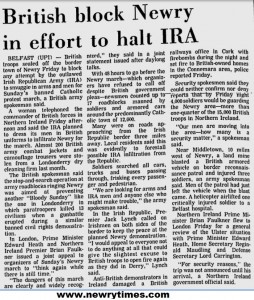Newry: A look back in time – 4000 British Army troops create ‘ring of steel’ around Newry
In our new column Newry Times columnist Sean O’Siridean takes a look back through the Newry of old. He takes a step back in time and looks at how history reported on Newry and the surrounding areas through past decades. Today Sean delves into the major military presence in Newry in 1972.
 It would seem that the Newry IRA in 1972 came up an ingenious plan to infiltrate the British Army in the town by threatening to dress as British soldiers. The week previous to this telephone threat, almost 200 British soldier uniforms were stolen from a launderette in Derry.
It would seem that the Newry IRA in 1972 came up an ingenious plan to infiltrate the British Army in the town by threatening to dress as British soldiers. The week previous to this telephone threat, almost 200 British soldier uniforms were stolen from a launderette in Derry.
The article however, dated 5th February 1972, from the Star newspaper, does shed light on the horrendous conditions the people of Newry had to live under, effectively martial law seemed to be in effect in the town.
An estimated 4,000 troops were deployed in the town after a protest march in anger at the massacre that the people witnessed happening in Derry a week earlier when British Paratroopers murdered 13 innocent civilians.
On 30th January 1972, in an ‘illegal’ Civil Rights march, the British Army deployed the 1st Battalion of the Parachute Regiment on to the streets of Derry to quell fierce rioting.
The Paratroopers indiscriminately opened fire on protestors, murdering 13 innocent civilians and injuring scores more.
The events of Bloody Sunday were broadcast all over the world and caused outrage and revulsion. The British government made an already volatile situation worse by claiming that all 13 killed were “gunmen and men carrying nail bombs” – a point ferociously denied by thousands of witnesses in Derry’s Bogside area and many Catholic clergymen who were there on that fateful day.
The ministry of defence claimed that IRA snipers opened fire first at British soldiers, trying to justify the huge death toll.
Furthermore, such disregard for human life put the British Government under severe pressure to address exactly what had happened. Northern Ireland was on the brink of civil war. Nationalists were disgusted at the treatment of their community and now had a siege mentality, creating Catholic ghettos free from the British Army and RUC personnel.
Meanwhile, Protestants became more alarmed that the situation may lead to a British withdrawal from the North and thus the UVF and UDA vowed to protect the union at all costs. A Provisional IRA man at the time argued that Bloody Sunday was “the greatest recruitment drive for the IRA” – as it turned non-political young people into Provisional IRA activists.
Tensions and emotions in Newry were clearly at breaking point. One must point out, the British army spokesperson really didn’t help matters when he released a statement saying that the reason there was such a heavy British military presence in Newry was ‘to prevent another Bloody Sunday’.
Every road leading to and from Newry was sealed off by British army road blocks in armoured vehicles. This, in hindsight, was noted by many as act of intimidation and a clear ploy to try and scare people away from the protest march.
In Dublin An Taoiseach, Jack Lynch pleaded with protesters “not to do anything that would give the British an excuse to open fire again as it did in Derry”.
Turbulent times indeed to be living in Newry and the surrounding areas, but times, that have undoubtedly made the areas stronger and more united.
More Newry history articles:
Newry: A look back in time – Newry Theatre bomb
Newry: A look back in time – Newry’s ‘Ghost Town’ makes international news
Newry: A look back in time – Bessbrook Canon Golden Jubilee
Short URL: https://newrytimes.com/?p=40027













